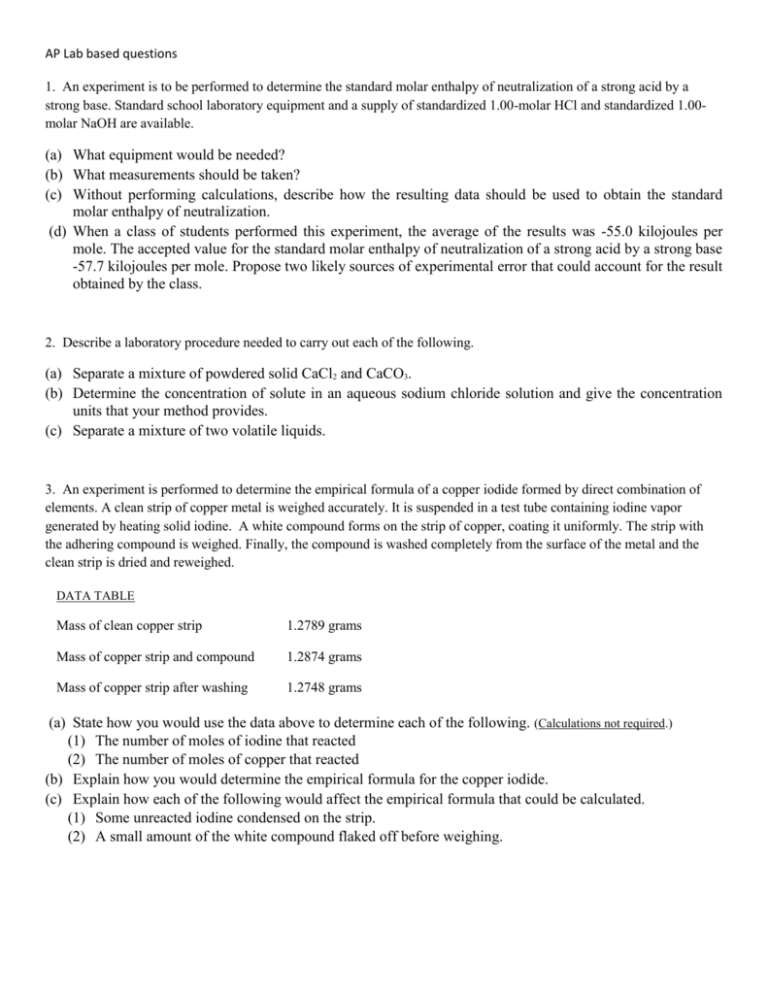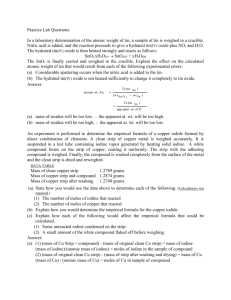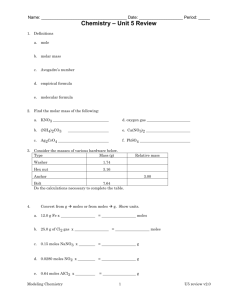AP Lab based questions
advertisement

AP Lab based questions 1. An experiment is to be performed to determine the standard molar enthalpy of neutralization of a strong acid by a strong base. Standard school laboratory equipment and a supply of standardized 1.00-molar HCl and standardized 1.00molar NaOH are available. (a) What equipment would be needed? (b) What measurements should be taken? (c) Without performing calculations, describe how the resulting data should be used to obtain the standard molar enthalpy of neutralization. (d) When a class of students performed this experiment, the average of the results was -55.0 kilojoules per mole. The accepted value for the standard molar enthalpy of neutralization of a strong acid by a strong base -57.7 kilojoules per mole. Propose two likely sources of experimental error that could account for the result obtained by the class. 2. Describe a laboratory procedure needed to carry out each of the following. (a) Separate a mixture of powdered solid CaCl2 and CaCO3. (b) Determine the concentration of solute in an aqueous sodium chloride solution and give the concentration units that your method provides. (c) Separate a mixture of two volatile liquids. 3. An experiment is performed to determine the empirical formula of a copper iodide formed by direct combination of elements. A clean strip of copper metal is weighed accurately. It is suspended in a test tube containing iodine vapor generated by heating solid iodine. A white compound forms on the strip of copper, coating it uniformly. The strip with the adhering compound is weighed. Finally, the compound is washed completely from the surface of the metal and the clean strip is dried and reweighed. DATA TABLE Mass of clean copper strip 1.2789 grams Mass of copper strip and compound 1.2874 grams Mass of copper strip after washing 1.2748 grams (a) State how you would use the data above to determine each of the following. (Calculations not required.) (1) The number of moles of iodine that reacted (2) The number of moles of copper that reacted (b) Explain how you would determine the empirical formula for the copper iodide. (c) Explain how each of the following would affect the empirical formula that could be calculated. (1) Some unreacted iodine condensed on the strip. (2) A small amount of the white compound flaked off before weighing. 4. T h e r m o m e te r Vo la til e L iq u id B o ili n g W a te r P in H o le A lu m in u m F o il R u b b er B an d An experiment is to be performed to determine the molecular mass of a volatile liquid by the vapor density method. The equipment shown above is to be used for the experiment. A barometer is also available. (a) (b) (c) (d) What data are needed to calculate the molecular mass of the liquid? What procedures are needed to obtain these data? List the calculations necessary to determine the molecular mass. If the volatile liquid contains non-volatile impurities, how would the calculated value of the molecular mass be affected? Explain your reasoning. 5. A student is instructed to determine the concentration of a solution of CoCl 2 based on absorption of light (spectrometric/colorimetric method). The student is provided with a 0.10 M solution of CoCl2 with which to prepare standard solutions with concentrations of 0.020 M, 0.040 M, 0.060 M and 0.080 M. (a) Describe the procedure for diluting the 0.10 M solutions to a concentration of 0.020 M using distilled water, a 100 mL volumetric flask, and a pipet or buret. Include specific amounts where appropriate. The student takes the 0.10 M solution and determines the percent transmittance and the absorbance at various wavelengths. The two graphs below represent the data. (b) Identify the optimum wavelength for the analysis. The student measures the absorbance of the 0.020 M, 0.040 M, 0.060 M, 0.080 M and 0.10 M solutions. The data are plotted below. (c) The absorbance of the unknown solution is 0.275. What is the concentration of the solution? (d) Beer’s Law is an expression that includes three factors that determine the amount of light that passes through a solution. Identify two of these factors. (e) The student handles the sample container (e.g., test tube or cuvette) that holds the unknown solution and leaves fingerprints in the path of the light beam. How will this affect the calculated concentration of the unknown? Explain your answer. (f) Why is this method of determining the concentration of CoCl2 solution appropriate, whereas using the same method for measuring the concentration of NaCl solution would not be appropriate? 6. A series of dyes are analyzed for molecular components using paper chromatography. The results are in the figure below: a. Define the following terms for relative to the experiment run in the figure above: stationary phase, solvent front, eluent and Rf. b. If the solvent used in the chromatography was polar, rank the pigments (red, blue and yellow) from most to least polar. Explain how you decided your ranking. c. Are the red molecules in the chromatogram likely to be the same molecule? Explain how you can support your argument quantitatively. Answers: 1. (a) Equipment needed includes a thermometer, and a container for the reaction, preferably a container that serves as a calorimeter, and volumetric glassware (graduated cylinder, pipet, etc.). (b) Measurements include the difference in temperatures between just before the start of the reaction and the completion of the reaction, and amounts (volumes, moles) of the acid and the base. (c) Determination of heat (evolved or absorbed): The sum of the volumes (or masses) of the two solutions, the change in temperature and the specific heat of water are multiplied together to determine the heat of solution for the sample used. (q = m.cp.T). Division of the calculated heat of neutralization by moles of water produced, or moles of H+, or moles of OH-, or moles of limiting reagent. (d) Experimental errors: heat loss to the calorimeter wall, to air, to the thermometer; incomplete transfer of acid or base from graduated cylinder; spattering of some of the acid or base so that incomplete mixing occurred… Experimenter error: dirty glassware, spilled solution, misread volume or temperature… 2. (a) Add water to the mixture. CaCO3 doesn’t dissolve, whereas, the CaCl2 does dissolve. Filter the solution. The aqueous CaCl2 solution passes through the filter paper and the CaCO3 is collected on the paper. (b) Pipet an aliquot of known volume into a flask. Add excess AgNO3 solution to precipitate AgCl. Filter, dry, and then weigh the AgCl. wt. AgC l mol . wt . AgCl M # mo l A gC l = # mo l N aC l mol AgCl (or NaCl) vo l. aliquo t in L OR Take a known volume of solution. Evaporate solution to dryness and weigh the NaCl residue. wt. NaC l M mol. wt. NaC l vo l. NaC l in L [other procedures possible, such as the use of colligative properties, etc.] (c) Fractional distillation. 3. (a) (1) (mass of Cu Strip + compound) - (mass of original clean Cu strip) = mass of iodine (mass of iodine)/(atomic mass of iodine) = moles of iodine in the sample of compound (2) (mass of original clean Cu strip) - (mass of strip after washing and drying) = mass of Cu (mass of Cu) / (atomic mass of Cu) = moles of Cu in sample of compound (b) The empirical formula is the ratio (moles iodine) / (moles Cu). OR (moles Cu) / (moles iodine). (c) (1) Unreacted I2 would make the apparent mass of compound and the iodine too high. Thus, the I:Cu ratio in the empirical formula would be too high. (2) If some compound flaked off, the mass of compound (and the I2) would be too low. Thus the I:Cu ratio in the empirical formula would be too low. 4. (a) 1. mass of flask + cap (foil) 2. mass of flask + cap + liquid 3. temp. of boiling water 4. barometric pressure 5. volume of flask (b) 1. Measure mass of empty flask w/cap 2. Pour about 3 mL of volatile liquid into flask. 3. Replace cap and place flask into boiling water. 4. Record temperature and barometric pressure. 5. When all the liquid has evaporated remove flask and allow to cool, wipe if necessary. 6. Weigh flask w/cap and condensed liquid. 7. Fill the flask completely with water and measure the volume by pouring the water into a graduated cylinder. (c) 1. calculated mass of condensed liquid (i.e. the mass of the vapor) 2. volume of vapor at STP 3. moles of vapor (from PV=nRT) 4. molecular weight of vapor = mass/mol (d) If non-volatile impurities were present it would make the calculated mass of condensed liquid larger than expected but not change the volume significantly. Therefore, the calculated molecular weight (in grams/mol) would be too large. 5. (a) M1V1 = M2V2; (0.10M)(V1) = (0.020M)(100. mL) V1 = 20.0 mL a 20.0 mL aliquot of 0.10 M solution is measured by buret or pipet. this aliquot is added to the 100-mL volumetric flask and filled, with mixing, to the line on the neck with distilled water (b) approx. 510 nm (c) approx. 0.05 M (d) extinction coefficient(molar absorptivity constant) path length of light concentration of absorbing species (e) fingerprints scatter light and the detector gets less light, the reading of absorbance is higher, indicating a higher than expected concentration (f) the Na+ ion does not absorb energy in the visible spectrum, whereas the Co2+ is a rose color 6. A series of dyes are analyzed for molecular components using paper chromatography. The results are in the figure below: a. Stationary phase is the phase that does not move, in this case, the paper. Solvent front is the highest point on the paper the eluent solution travels; it is the line drawn across the top of the paper. Eluent is the solvent (solution) used to develop the chromatogram. It wicks up the paper and carries the molecules to be analyzed with it, depending on how attracted the molecules are to the solvent. Rf is the proportion a dye molecule travels relative to the distance the solvent front travels. b. Blue > Yellow > Red. Because blue travels farther up the chromatogram, it is most attracted to the polar eluent. The red is least attracted. c. Probably. You would calculate the Rf values to compare. It seems likely that the first four columns will have an Rf close to the same. However, the fifth column appears to have a greater Rf then the other reds. This may be due to a more polar molecule, but more likely it is because the red dye only has the red molecule. As a result of not having other molecules in a mixture, the single molecule will tend to move farther with the eluent then it would in a mixture.







